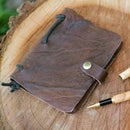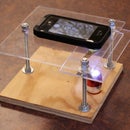Introduction: Throwing Arrows
Throwing arrows are an incredibly fun and easy to make projectile. At their simplest, they consist of a notched shaft, fletchings, and a counter weight. With the aid of a length of string, these arrows can be thrown great distances. With a tailwind I have thrown them as far as 150 yards.
With about a dollar's worth of materials from the hardware store you too can be throwing these arrows in under ten minutes.
Watch the above video to see these arrows being thrown!
Why make these, you ask?
YOU CAN THROW A POINTY STICK OVER A HUNDRED YARDS!
If that doesn't sway you here are a few other reasons:
- Throwing arrows are a simple project that requires only a few tools and materials you likely already have
- The physics behind their flight is extremely interesting
- You can play lawn darts on a football field with your friends
- They are the perfect weapon for hunting low flying cumulonimbus clouds
So the real question is, "why not make throwing arrows?"
There is no legitimate or acceptable answer to that question. Keep reading.
Warning: These arrows can be dangerous. Make sure that you never throw an arrow when someone is standing in front of you. Never throw arrows into an area that you can not see.
Step 1: What You'll Need. Also a Few Design Notes
Throwing arrows can be made out of many different materials.
Materials:
- Shaft - Any straight and long material will do. Dowels, broomsticks, bamboo, branches and old arrows all work. Length: 1 1/2' - 4'
- Points/Counterweights - Nuts, and arrow heads are perfect. If using nuts, pick one that is slightly smaller inner diameter than the diameter of the shaft.
- Fletchings - Cardboard, feathers and arrow vanes all work well. To attach the cardboard use duct tape, for feathers use superglue.
- String - a length ~1' longer than the arrow. I use paracord. I have also had success with cotton twine.
In this instructable we will make a 30" throwing arrow from a 3/8" poplar dowel, a 5/16" nut, and cardboard flights.
Tools:
- Knife (or anything to taper the dowel)
- Scissors (to cut flights from cardboard)
A few notes on design:
I have made arrows of all different lengths, materials, and weights. The ideal arrow has a center of mass about 1/3 from the front. However, even without a counterweight many of these arrows have flown >100 yards. The distances indicated for the arrows below is the average of 5 throws. The lettered arrows are the arrows above in the photos.
- A - 91 yards - 3/4" broomstick handle, 36", cardboard fletched, nut counterweight
- B - 138 yards - 7/16" dowel, 30", cardboard fletched, nut counterweight
- C - 127 yards - 3/8" dowel, 30", feather fletched, 100g glue on field point
- D - 115 yards - 5/16" arrow, 28", feather fletched, crimp on target tip
- E - 119 yards - 3/8" arrow, 29", feather fletched, 100g broad head
Not pictured:
- 129 yards - 7/16" dowel, 28", cardboard fletched, glue on field points
- 125 yards - 7/16" dowel, 48", cardboard fletched, nut counterweight
- 117 yards - 7/16" dowel, 36", cardboard fletched, no counterweight
- 94 yards - 1/2" dowel, 24", cardboard fletched, nut counterweight
- 106 yards, 1/4" bamboo stake, 36", cardboard fletched, no counterweight
The takeaway is that pretty muchany combination of materials will produce a useable arrow.
Step 2: Tapering the Point
Taper the end of the dowel (or whatever you are using as the shaft) with a knife. Be careful to cut away from you!
If you are making several arrows at a time I would speed this process up with another tool. I've used everything from a rotary tool, disc sander, and a band saw to taper the arrows.
Lock the nut onto the tapered end of the dowel with a strong twist.
Step 3: Fletching the Arrow
If you are fletching with cardboard, first cut some triangular flights with scissors.
Rip a narrow piece of duct tape and adhere it to the edge of the flight so that the tape is half on and off the fletching.
Carefully line up the edge of the fletching along the dowel. Its important to attach the fletching as straight as possible.
Press the tape down and repeat with the other side of the cardboard.
Rotate the arrow 120˚ and repeat twice more!
Clean up the flights with scissors by trimming the fronts even.
Again, instead of tape and cardboard you can use glue and normal arrow fletchings. I have not noticed a significant increase in distance from the arrows fletched with feathers.
For extra credit, fletch your arrows with feathers using this fletching jig instructable. It will make fletching go far quicker and be more consistent.
Step 4: Cutting the Notch
The notch in the shaft must go right in front of the fletchings. First cut perpendicular to the shaft with the blade. Only go as deep as 1/3 the diameter of the shaft. Starting just below the fletchings, make angled cuts toward the first cut in the shaft. Remember to cut away from you if you are using a knife! A rotary tool would also work well in this step.
Important note: Do not cut the notch deeper than 1/3 the diameter of the shaft. Doing so will greatly increase the likelihood of your arrow breaking on impact with the ground after a long throw.
Your arrow is now ready to throw. You just need a string!
Step 5: Preparing the String
The length of the string should be about a foot longer than the length of your arrow. It will help to have a little excess to wrap around your hand when throwing.
Tie an overhand knot in the end of the string. If you are using a synthetic material like the paracord pictured above, you can melt the end to stop it from fraying.
Step 6: How to Throw
First, find yourself a field. Really. These things will go much further than you expect. When thrown correctly they can easily travel over 100 yards.
To throw the arrow:
1. Place the knotted end of the arrow in the side of the notch of the arrow.
2. Wrap the string around the back of the arrow and over the knot. This will lock it in place.
3. Bring the excess string down the arrow to the front. Be sure to wind the string once around the shaft.
4. Wind the excess string around your hand that will throw the arrow.
5. Check to make sure the string on the arrow is taut.
6. Hold the arrow like a dart, wind up your throwing arm behind your body, step forward with the opposite leg, throw (like a baseball throw), and FOLLOW THROUGH with your arm.
Watch the gifs above (or in higher quality here in this video) for a step by step of the wrap and throw.
For extra distance, perform a small crow hop before the throw. If distance is your goal, block your front leg (place it well in front of you when you land on the hop) and tilt your torso up so that you can release the arrow at 45˚ angle.
Step 7: Why This Works
I have consulted with a few physicists and javelin throwers about the science behind these arrows. The following is the most reasonable explanation that we've come up with:
1. Range of motion - When the dart is thrown with the string, the range of motion that you are in contact with the arrows is greatly increased. This in turn means more energy transferred to the projectile.
2. Spin stabilization - The string that is wrapped around the shaft forces the arrow to spin as it leaves your hand. The imparted spin will stabilize the arrow throughout its flight. Projectiles that don't spin are incredibly inaccurate and don't fly very far. For example, musket balls (no spin) vs. rifled bullets. Muskets were notoriously inaccurate as the balls would rattle down and exit a smoothbore barrel in a random direction with no regular spin. The grooves on the inside of the barrel of a rifle force the bullets to spin as they are shot. Rifled bullets have far superior accuracy and range.
3. Force applied to the back of the arrow - When pulling on the string after letting go with your hand you are applying force nearly at the back end of the arrow. This is far more efficient than applying force only at the center of mass.
To prove some of this to yourself, try throwing the arrow like a dart without the string. Try holding the arrow near the point. The flight will be short and extremely erratic. Now try throwing the arrow holding it nearly at the fletchings. The arrow should travel further and be more accurate. Throw the arrow with your feet planted, and minimal rotation of your hips. It likely won't travel far.
Step 8: Play! Experiment!
Now that you have a beautiful new throwing arrow, go figure out what can be done with it.
See how far you can throw them!
My friends and I go clout throwing. Set up targets at different distances and see who can land arrows closest to them.
Play lawn darts on a huge field!
Experiment with the materials, lengths and masses of different arrows. Figure out what works for you. Post photos of your arrows and your experiments.
Thanks for reading. Have fun, be safe, and go make some arrows!
Step 9: Troubleshooting!
Look here for answers to some common questions about the arrows and how to throw them.
Help! My arrows aren't going anywhere!?
1. Tension. If the string is not taut, then the knot can slip from the notch during the throw. If this happens you won't get any of the benefits of throwing with a string!
2. Block your front leg and aim high. To maximize your distance you need to throw at a 45˚ angle. Set your foot out in far front of you so that your center of mass is behind it when throwing. Turn your hips slightly up as you transfer your weight to your front foot during the throw.
3. Followthrough. This is critical. If you don't follow through the motion of the throw then the string will do nothing.
4. Trim your fletchings. Larger fletchings cause increased spin (if fletched correctly) but also increased drag. Drag force will rob your arrows of distance. Experiment with the shape and size of fletching. Find what works best for you!
My arrows are fishtailing early on in their flight!
1. Tension. If the string is not taut and the knot holds during the throw, the string will jerk the back end of the arrow as the tension is regained after your release with your hand. This will cause a horrible fishtailing motion in the flight and a great loss of distance.
2. Too many wraps around the shaft. If you wrap more than one full rotation around the shaft with the cord then your arrows will likely have an unstable early flight.
3. Refletch your arrows. If the fletchings are not attached straight then the arrow will have trouble stabilizing itself in flight.
My arrows are breaking!
1. Your notches may be cut too deep. I have broken a half dozen arrows. What they all had in common is that I cut the notch half way through the shaft of the arrow. I have only broken two arrow that had its notch cut a third of the way in. Those arrows broke because...
2. The ground your arrows are landing on is too hard! I overthrew a couple and the arrows struck pavement. Try to make sure your arrows strike a softer surface like grass.
3. Lengthen the taper. If you are using a nut to counterweight the arrows, try lengthening the taper. This will cause the arrow to dissipate more force on landing before it hits a hard stop.

Runner Up in the
Great Outdoors Contest

Second Prize in the
Launch It! Contest

Participated in the
Outdoor Workshop Contest













